State control but local management
Page 114
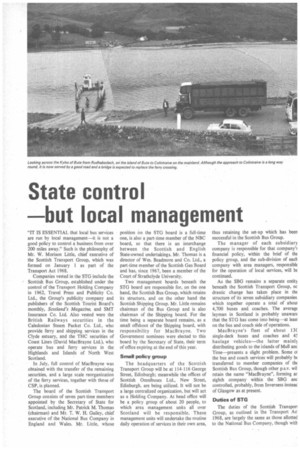
Page 115
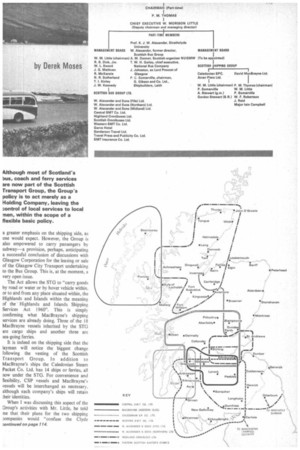
Page 116
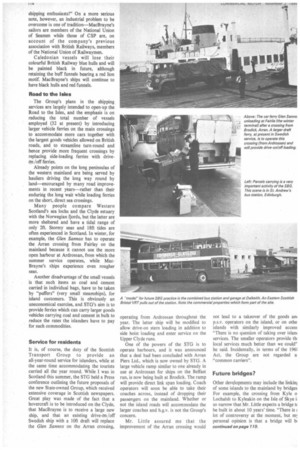
Page 121
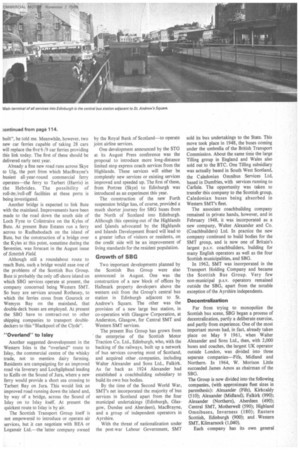
Page 122
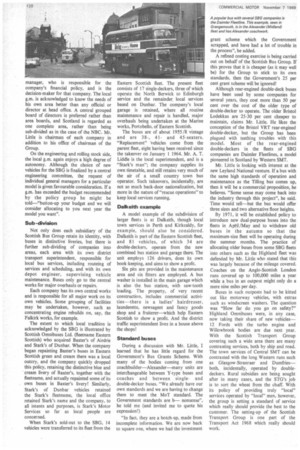
Page 123
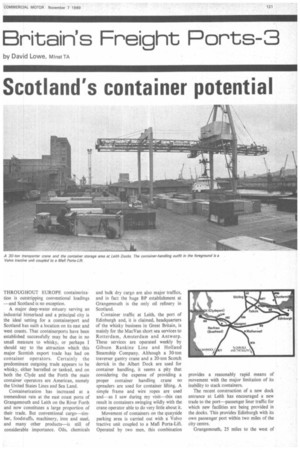
Page 124
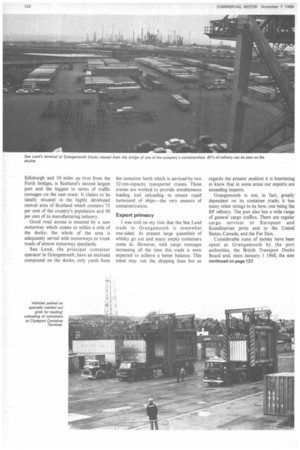
Page 129
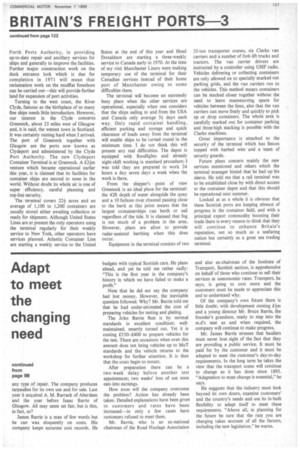
If you've noticed an error in this article please click here to report it so we can fix it.
"IT IS ESSENTIAL that local bus services are run by local management—it is not a good policy to control a business from over 200 miles away." Such is the philosophy of Mr, W. Morison Little, chief executive of the Scottish Transport Group, which was formed on January 1 as part of the Transport Act 1968.
Companies vested in the STG include the Scottish Bus Group, established under the control of the Transport Holding Company in 1962, Travel Press and Publicity Co. Ltd., the Group's publicity company and publishers of the Scottish Tourist Board's monthly, Scotland's Magazine, and SMT Insurance Co. Ltd. Also vested were the British Railways securities in the Caledonian Steam Packet Co. Ltd., who provide ferry and shipping services in the Clyde estuary, and the THC securities of Coast Lines (David MacBrayne Ltd.), who operate bus and ferry services in the Highlands and Islands of North West Scotland.
In July, full control of MacBrayne was obtained with the transfer of the remaining securities, and a large scale reorganization of the ferry services, together with those of CSP, is planned.
The board of the Scottish Transport Group consists of seven part-time members appointed by the Secretary of State for Scotland, including Mr. Patrick M. Thomas (chairman) and Mr. T. W. H. Gailey, chief executive of the National Bus Company in England and Wales. Mr. Little, whose position on the STG board is a full-time one, is also a part-time member of the NBC board, so that there is an interchange between the Scottish and English State-owned undertakings. Mr. Thomas is a director of Wm. Beadmore and Co. Ltd., a part-time member of the Scottish Gas Board and has, since 1967, been a member of the Court of Strathclyde University.
Two management boards beneath the STG board are responsible for, on the one hand, the Scottish Bus Group, which retains its structure, and on the other hand the Scottish Shipping Group. Mr. Little remains chairman of the Bus Group and is also chairman of the Shipping board. For the time being a separate board remains, as a small offshoot of the Shipping board, with responsibility for MacBrayne. Two Government nominees were elected to this board by the Secretary of State, their term of office expiring at the end of this year.
Small policy group The headquarters of the Scottish Transport Group will be at 114-116 George Street, Edinburgh; meanwhile the offices of Scottish Omnibuses Ltd., New Street, Edinburgh, are being utilized. It will not be a large centralized organization, but will act as a Holding Company. At head office will be a policy group of about 20 people, to which area management units all over Scotland will be responsible. These management units will undertake the routine daily operation of services in their own area,
thus retaining the set-up which has been successful in the Scottish Bus Group.
The manager of each subsidiary company is responsible for that company'5 financial policy, within the brief of the policy group, and the sub-division of each company with area managers, responsible for the operation of local services, will be continued.
As the SBG remains a separate entity beneath the Scottish Transport Group, nc drastic change has taken place in the structure of its seven subsidiary companies which together operate a total of about 4,700 buses and, coaches. The average layman in Scotland is probably unaware that the STG has come into being----at least on the bus and coach side of operations.
MacBrayne's fleet of about 13( single-deck buses and coaches and 4f, haulage vehicles—the latter mainly distributing goods to the islands of Mull ant Tiree—presents a slight problem. Some oi the bus and coach services will probably be transferred to member companies of the Scottish Bus Group, though other p.s.v. wil retain the name "MacBrayne", forming at eighth company within the SBG anc controlled, probably, from Inverness insteac of Glasgow as at present.
Duties of STG The duties of the Scottish Transpor Group, as outlined in The Transport Ac 1968, are largely the same as those allotted to the National Bus Company, though with
a greater emphasis on the shipping side, as one would expect. However, the Group is also empowered to carry passengers by subway—a provision, perhaps, anticipating a successful conclusion of discussions with Glasgow Corporation for the leasing or sale of the Glasgow City Transport undertaking to the Bus Group. This is, at the moment, a very open issue.
The Act allows the STG to "carry goods by road or water or by hover vehicle within. or to and from any place situated within, the Highlands and Islands within the meaning of the' Highlands and Islands Shipping Services Act 1960". This is simply confirming what MacBrayne's shipping services are already doing. Three of the 18 MacBrayne vessels inherited by the STG are cargo ships and another three are sea-going ferries.
It is indeed on the shipping side that the layman will notice the biggest change Following the vesting of the Scottish Transport Group. In addition to MacBrayne's ships the Caledonian Steam Packet Co. Ltd. has 14 ships or ferries, all now under the STG. For convenience and CSP vessels and MacBrayne's vessels will be interchanged as necessary. although each company's ships will retain :heir identities.
When I was discussing this aspect of the Group's activities with Mr. Little, he told mie that their plans for the two shipping companies would "confuse the Clyde shipping enthusiasts!" On a more serious note, however, an industrial problem to be overcome is one of tradition—MacBrayne's sailors are members of the National Union of Seamen while those of CSP are, on account of the company's previous association with British Railways, members of the National Union of Railwaymen.
Caledonian vessels will lose their colourful British Railway blue hulls and will be painted black in future, although retaining the buff funnels bearing a red lion motif. MacBrayne's ships will continue to have black hulls and red funnels.
Road to the Isles The Group's plans in the shipping services are largely intended to open-up the Road to the Isles, and the emphasis is on reducing the total number of vessels employed (32 at present) by introducing larger vehicle ferries on the main crossings to accommodate more cars together with the largest goods vehicles allowed on British roads, and to streamline turn-round and hence provide more frequent crossings by replacing side-loading ferries with driveon/off ferries.
Already points on the long peninsulas of the western mainland are being served by hauliers driving the long way round by land—encouraged by many road improvements in recent years—rather than their enduririg the long wait while loading ferries on the short, direct sea crossings_
Many people compare Western Scotland's sea lochs and the Clyde estuary with the Norwegian fjords, but the latter are more sheltered and have a tidal range of only 2ft. Stormy seas and 18ft tides are often experienced in Scotland. In winter, for example, the Glen Sannox has to operate the Arran crossing from Fairley on the mainland because it cannot use the more open harbour at Ardrossan, from which the summer service operates, while MacBrayne's ships experience even rougher seas.
Another disadvantage of the small vessels is that such items as coal and cement carried in individual bags, have to be taken by "puffers" (very small steamships), for island customers. This is obviously an uneconomical exercise, and STO's aim is to provide ferries which can carry larger goods vehicles carrying coal and cement in bulk to reduce the rates the islanders have to pay for such commodities.
Service for residents
It is, of course, the duty of the Scottish Transport Group to provide an all-year-round service for islanders, while at the same time accommodating the tourists carried all the year round. While I was in Scotland this summer, the STG held a Press conference outlining the future proposals of the new State-owned Group, which received extensive coverage in Scottish newspapers. Great play was made of the fact that a hovercraft is to be introduced on the Clyde, that MacBrayne is to receive a large new ship, and that an existing drive-on/off Swedish ship with a 10ft draft will replace the Glen Sannox on the Arran crossing,
operating from Ardrossan throughout the year. The latter ship will be modified to allow drive-on stern loading in addition to side hoist loading and enter service on the Upper Clyde runs.
One of the powers of the STG is to operate harbours, and it was announced that a deal had been concluded with Arran Piers Ltd., which is now owned by STG. A large vehicle ramp similar to one already in use at Ardrossan for ships on the Belfast run, is now being built at Brodick. The ramp will provide direct link span loading. Coach operators will soon be able to take their coaches across, instead of dropping their passengers on the mainland. Whether or not the island roads will accommodate the larger coaches and h.g.v. is not the Group's concern.
Mr, Little assured me that the improvement of the Arran crossing would not lead to a takeover of the goods ant p.s.v. operators on the island, or on othe islands with similarly improved access "There is no question of taking over islarn services. The smaller operators provide till local services much better than we could" he said. Incidentally, in terms of the 196/ Act, the Group are not regarded a: "common carriers".
Future bridges?
Other developments may include the linkirq of some islands to the mainland by bridges For example, the crossing from Kyle o Lochalsh to Kylealcin on the Isle of Skye i: so narrow that Mr. Little expects a bridge u be built in about 10 years' time. "There is i lot of controversy at the moment, but nal personal opinion is that a bridge will bi
built-, he told me. Meanwhile, however, two new car ferries capable of taking 28 cars will replace the five--6 /9 car ferries providing this link today. The first of these should be delivered early next year.
Already a fine new road runs across Skye to Uig, the port from which MacBrayne's busiest all-year-round commercial ferry operates—the ferry to Tarbert (Harris) in the Hebrides. The possibility of roll-On /roll-off facilities at these ports is being investigated.
Another bridge is expected to link Bute with the mainland. Improvements have been made to the road down the south side of Loch Fyne to Cohntraive on the Kyles of Bute. At present Bute Estates run a ferry across to Rudhabodach on the island of Bute, but the construction of a bridge over the Kyles at this point, sometime during the Seventies, was forecast in the August issue of Sebttish Field
Although still a roundabout route to reach Bute, such a bridge would ease one of the problems of the Scottish Bus Group. Bute is probably the only off-shore island on which SBG services operate at present, the company concerned being Western SMT. So busy are services around Rothesay, to which the ferries cross from Gourock or Wemyss Bay on the mainland, that double-deck buses are employed. At present the SBG have to contract-out to other shipping companies to transport doubledeckers to this "Blackpool of the Clyde".
"Overland" to Islay
Another suggested devevelopment in the Western Isles is the "overland" route to Islay, the commercial centre of the whisky trade, not to mention dairy farming. Residents are campaigning for an improved road via Inverary and Lochgilphead leading to Keills on the Sound of Jura, where a new ferry would provide a short sea crossing to Tuber! Bay on Jura. This would link an improved road running down the island and, by way of a bridge, across the Sound of Islay on to Islay itself. At present the quickest route to Islay is by air.
The Scottish Transport Group itself is not empowered to introduce or operate air services, but it can negotiate with BEA or Loganair Ltd.—the 'latter company owned by the Royal Bank of Scotland—to operate joint airline services.
One development announced by the STG at its August Press conference was the proposal to introduce more long-distance limited stop express coach services from the Highlands. These services will either be completely new services or existing services improved and speeded up. The first of these, from Port ree (Skye) to Edinburgh was introduced as an experiment this year.
The construction of the new Forth suspension bridge has, of course, provided a much shorter journey for SBG buses from the North of Scotland into Edinburgh. Although this opening-out of the Highlands and blands advocated by the Highlands and Islands Development Board will lead to a greater influx of visitors or residents, on the credit side will be an improvement of living standards for the resident population.
Growth of SBG
Two important developments planned by the Scottish Bus Group were also announced in August. One was the construction of a new block of offices by Hallmark property developers above the western exit from the Group's central bus station in Edinburgh adjacent to St. Andrew's Square. The other was the provision of a new large bus station, in co-operation with Glasgow Corporation, at Anderston, Glasgow, for Central SMT and Western SMT services.
The present Bus Group has grown from ' the enterprise of the Scottish Motor Traction Co. Ltd., Edinburgh, who, with the backing of the railways, built up a network of bus services covering most of Scotland, and acquired other companies, including Walter Alexander and Sons Ltd., Falkirk. As far back as 1924 Alexander had established a coachbuilcling subsidiary to build its own bus bodies.
By the time of the Second World War, SMT's net incorporated the majority of bus services in Scotland apart from the four municipal undertakings (Edinburgh, Glasgow, Dundee and Aberdeen), MacBrayne, and a group of independent operators in Ayrshire.
With the threat of nationalization under the post-war Labour Government, SMT sold its bus undertakings to the State. This move took place in 1948, the buses coming under the umbrella of the British Transport Commission. About the same time the large Tilling group in England and Wales also sold out to the BTC. One Tilling subsidiary was actually based in South West Scotland, the Caledonian Omnibus Services Ltd, based in Dumfries, with services running to Carlisle. The opportunity was taken to transfer this company to the Scottish group, Caledonian buses being absorbed in Western SMT's fleet.
The associate coachbuilciing company remained in private hands, however, and in February 1948, it was incorporated as a new company, Walter Alexander and Co. (Coachbuilders) Ltd. In practice the new company continued to build bodies for the SMT group, and is now one of Britain's largest p.s.v. coachbuilders, building for many English operators as well as the four Scottish municipalities, and SBG.
In 1962, SMT was incorporated in the Transport Holding Company and became the Scottish Bus Group. Very few non-municipal p.s.v. operators remained outside the SBG, apart from the notable exception of the Ayrshire independents.
Decentralization
Far from trying to monopolize the Scottish bus scene, SBG began a process of decentralization, partly a deliberate exercise, and partly from experience. One of the most important moves had, in fact, already taken place on May 9 1961, when Walter Alexander and Sons Ltd., then, with 2,000 buses and coaches, the largest UK operator outside London, was divided into three separate companies—Fife, Midland and Northern. In 1964, W. Morison Little succeeded James Amos as chairman of the SBG.
The Group is now divided into the following companies, (with approximate fleet sizes in parenthesis): Alexander (Fife), Kirkcaldy (510); Alexander (Midland), Falkirk (990); Alexander (Northern), Aberdeen (490); Central SMT, Motherwell (590); Highland Omnibuses, Inverness (180); Eastern Scottish, Edinburgh (900); and Western SMT, Kilmarnock (1,040).
Each company has its own general manager, who is responsible for the company's financial policy, and is the decision-maker for that company. The local g.m. is acknowledged to know the needs of his own area better than any official or director at head office. A central grouped board of directors is preferred rather than area boards, and Scotland is regarded as one complete area, rather than being sub-divided as in the case of the NBC. Mr. Little is chairman of each company in addition to his office of chairman of the Group.
On the engineering and rolling stock side, the local g.m. again enjoys a high degree of autonomy. Although the choice of new vehicles for the SBG is finalized by a central engineering committee, the request of individual general managers for a particular model is given favourable consideration. If a g.m. has exceeded the budget recommended by the policy group he might be told—"button-up your budget and we will consider allocating to you next year the model you want".
Sub-division
Not only does each subsidiary of the Scottish Bus Group retain its identity, with buses in distinctive liveries, but there is further sub-dividing of companies into areas, each area with its own district transport superintendent, responsible for local bus services, including routeing of services and scheduling, and with its own depot engineer, supervising vehicle maintenance. Buses only go to the central works for major overhauls or repairs.
Each company has its own central works and is responsible for all major work on its own vehicles. Some grouping of facilities may be undertaken, however, such as concentrating engine rebuilds on, say, the Falkirk works, for example.
The extent to which local tradition is acknowledged by the SBG is illustrated by Scottish Omnibuses Ltd. (fleetname Eastern Scottish) who acquired Baxter's of Airdrie and Stark's of Dunbar. When the company began repainting Baxter's buses in Eastern Scottish green and cream there was a local outcry, and the company quickly dropped this policy, retaining the distinctive blue and cream livery of Baxter's, together with the fleetname, and actually repainted some of its own buses in Baxter's livery! Similarly, Stark's of Dunbar vehicles retained the Stark's fleetname, the local office retained Stark's name and the company, to all intents and purposes, is Stark's Motor Services so far as local people are concerned.
When Stark's sold-out to the SBG, 14 vehicles were transferred to its fleet from the Eastern Scottish fleet. The present fleet consists of 17 single-deckers, three of which operate the North Berwick to Edinburgh service and the remainder, local services based on Dunbar. The company's local garage is retained, where all routine maintenance and repair is handled, major overhauls being undertaken at the Marine works, Portobello, of Eastern Scottish.
The buses are of about 1955 /8 vintage and are 38-, 41and 45-seaters. "Replacement" 'vehicles come from the parent fleet, eight having been received since the takeover on January 1 1964. Mr. A. T. Liddle is the local superintendent, and is a "Stark's man"; the company supplies its own timetable, and still retains very much of the air of a small country town bus operator. Such takeovers, incidentally, are not so much back-door nationalization, but more in the nature of "rescue operations" to keep local services running.
Dalkeidt example
A model example of the subdivision of larger fleets is at Dalkeith, though local town services in Perth and Kirkcaldy, for example, should also be considered. Dalkeith is part of the Eastern Scottish fleet, and 81 vehicles, of which 34 are double-deckers, operate from the new combined bus station and garage there. The unit employs 126 drivers, does its own book-keeping, and aims to show a profit.
Six pits are provided in the maintenance area and six fitters are employed. A bus washer is installed in the main garage which is also the bus station, with saw-tooth loading. The property, of very recent construction, includes commercial activities—there is a ladies' hairdresser, launderette, newsagent and fancy goods shop and a fruiterer—which help Eastern Scottish to show a profit. And the district traffic superintendent lives in a house above the shops!
Standard buses
During a discussion with Mr. Little, I learned that he has little regard for the Government's Bus Grants Scheme. With many of the bodies coming from one coachbuilder—Alexander—many units are interchangeable between Y-type buses and coaches and between singleand double-decker buses. "We already have our own standards and we are having to change them to meet the MoT standard. The Government standards are b— nonsense", he told me (and invited me to quote his expression!)
"In fact, they are a botch-up, made from incomplete information. We are now back to square one, where we had the investment grant scheme which the Government scrapped, and have had a lot of trouble in the process", he added.
A refined costing exercise is being carried out on behalf of the Scottish Bus Group. If this proves that it is cheaper (as it may well be) for the Group to stick to its own standards, then the Government's 25 per cent grant scheme will be ignored!
Although rear-engined double-deck buses have been used by some companies for several years, they cost more than 50 per cent over the cost of the older type of double-decker to operate. The older Bristol Lodekkas are 25-30 per cent cheaper to maintain, claims Mr. Little. He likes the conception of the Bristol VRT rear-engined double-decker, but the Group has been plagued with teething troubles with this model. Most of the rear-engined double-deckers in the fleets of SBG companies are Daimler Eleetlines, a model pioneered in Scotland by Western SMT.
Mr. Little is looking with interest at the new Leyland National venture. If a bus with the same high standards of operation and maintenance as the Tilling bus comes up, then it will be a commercial proposition, he believes. "Some sense may come back into the industry through this project", he said. Time would tell—but the bus would offer three sizes and two alternative floor heights.
By 1971, it will be established policy to introduce new dual-purpose buses into the fleets in April /May and to withdraw old buses in the autumn so that the maximum-size fleet will be operating during the summer months. The practice of allocating older buses from some SBG fleets into others such as the Highland fleet was defended by Mr. Little who stated that this was largely because of the mileage covered. Coaches on the Anglo-Scottish London runs covered up to 100,000 miles a year while a bus in an outpost might only do a mere nine miles per day.
Buses in such outposts had to be kitted out like motorway vehicles, with extras such as windscreen washers. The question was "How far do you go on safety?" Highland Omnibuses were, in any case, now taking their share of new vehicles12 Fords with the turbo engine and Willowbrook bodies are due next year. With the Scottish Transport Group covering such a wide area there are many contrasting services, both by ship and road. The town services of Central SMT can be contrasted with the long Western runs such as Glasgow-Stranraer and Dumfries— both, incidentally, operated by doubledeckers. Rural subsidies are being sought after in many cases, and the STG's job is to sort the wheat from the chaff. With its policy of providing truly "local" services operated by "local" men, however, the group is setting a standard of service which really should provide the best to the customer. The setting-up of the Scottish Transport Group is one part of the Transport Act 1968 which really should work. THROUGHOUT EUROPE containerization is outstripping conventional loadings —and Scotland is no exception.
A major deep-water estuary serving an industrial hinterland and a principal city is the ideal setting for a containerport and Scotland has su'ch a location on its east and west coasts. That containerports have been established successfully may be due in no small measure to whisky, or perhaps I should say to the attraction which this major Scottish export trade has had on container operators. Certainly the predominant outgoing trade appears to be whisky, either barrelled or tanked, and on both the Clyde and the Forth the main container operators are American, namely the United States Lines and Sea Land.
Containerization has increased at a tremendous rate at the east coast ports of Grangemouth and Leith on the River Forth and now constitutes a large proportion of their trade. But conventional cargo—timber, foodstuffs, machinery, iron and steel, and many other products—is still of considerable importance. Oils, chemicals and bulk dry cargo are also major traffics, and in fact the huge BP establishment at Grangemouth is the only oil refinery in Scotland.
Container traffic at Leith, the port of Edinburgh and, it is claimed, headquarters of the whisky business in Great Britain, is mainly for the MacVan short sea services to Rotterdam, Amsterdam and Antwerp. These services are operated weekly by Gibson Rankine Line and Holland Steamship Company. Although a 30-ton traverser gantry crane and a 20-ton Scotch derrick in the Albert Dock are used for container handling, it seems a pity that considering the expense of providing a proper container handling crane no spreaders are used for container lifting, A simple frame and wire ropes are used and—as I saw during my visit—this can result in containers swinging wildly with the crane operator able to do very little about it.
Movement of containers on the quayside parking area is carried out with a Volvo tractive unit coupled to a Mafi Porta-Lift. Operated by two men, this combination provides a reasonably rapid means of movement with the major limitation of its inability to stack containers.
The recent construction of a new dock entrance at Leith has encouraged a new trade to the port—passenger liner traffic for which new facilities are being provided in the docks. This provides Edinburgh with its own passenger port within two miles of the city centre.
Grangemouth, 25 miles to the west a
Edinburgh and 10 miles up river from the Forth bridges, is Scotland's second largest port and the biggest in terms of traffic tonnages on the east coast. It claims to be ideally situated in the highly developed central area of Scotland which contains 75 per cent of the country's population and 90 per cent of its manufacturing industry.
Good road access is ensured by a new motorway which comes to within a mile of the docks; the whole of the area is adequately served with motorways or trunk roads of almost motorway standards.
Sea Land, the principal container operator in Grangemouth, have an enclosed compound on the docks, only yards from the container berth which is serviced by two 32-ton-capacity transporter cranes. These cranes are worked to provide simultaneous loading and unloading to ensure rapid turnround of ships—the very essence of containerization.
Export primacy I was told on my visit that the Sea Land trade in Grangemouth is somewhat one-sided. At present large quantities of whisky go out and many empty containers come in. However, with cargo tonnages increasing all the time this trade is soon expected to achieve a better balance. This trend may suit the shipping lines but as regards the present position it is heartening to know that in some areas our exports are exceeding imports.
Grangemouth is not, in fact, greatly dependent on its container trade; it has many other strings to its bow, one being the BP refinery. The port also has a wide range of general cargo traffics. There are regular cargo services to European and Scandinavian ports and to the United States, Canada, and the Far East.
Considerable sums of money have been spent at Grangemouth by the port authorities, the British Transport Docks Board and, since January 1 1968, the new continued on page 127 Forth Ports Authority, in providing up-to-date repair and ancillary services for ships and generally to improve the facilities. Further major construction work on the dock entrance lock which is due for completion in 1971 will mean that reclamation work on the mudflat foreshore can be carried out—this will provide further land for expansion of port activities.
Turning to the west coast, the River Clyde, famous as the birthplace of so many fine ships needs little introduction. However, our interest in the Clyde concerns Greenock, about 23 miles west of Glasgow and, it is said, the wettest town in Scotland. It was certainly raining hard when I arrived. The port of Greenock together with Glasgow are the ports now known as Clydeport and administered by the Clyde Port Authority. The new Clydeport Container Terminal is at Greenock. A f24m venture which became operational earlier this year, it is claimed that its facilities for container ships are second to none in the world. Without doubt its whole air is one of super efficiency, careful planning and top-line security.
The terminal covers 22+ acres and an average of 1,100 to 1,200 containers are usually stored either awaiting collection or ready for shipment. Although United States Lines are at present the only operators using the terminal regularly for their weekly service to New York, other operators have services planned. Atlantic Container Line are starting a weekly service to the United States at the end of this year and Head Donaldson are starting a three-weekly service to Canada early in 1970. At the time of my visit Manchester Liners were making temporary use of the terminal for their Canadian services instead of their home port of Manchester owing to some difficulties there.
The terminal will become an extremely busy place when the other services are operational, especially when one considers that the ships sailing to and from the USA and Canada only average 5+ days each way. Only rapid container handling, efficient parking and storage and quick clearance of loads away from the terminal will enable ships to be turned round in the minimum time. I do not think this will present any real difficulties. The depot is equipped with floodlights and already night-shift working is standard procedure; I was told they are prepared to work 24 hours a day seven days a week when the work is there.
From the shipper's point of view Greenock is an ideal place for the terminal: the 42ft depth of water alongside the quay and a 10 fathom river channel passing close to the bank at this point means that the largest containerships can berth or sail regardless of the tide. It is claimed that fog is not much of a problem in the area. However, plans are afoot to provide radar-assisted berthing when this does occur.
Equipment in the terminal consists of two
35-ton transporter cranes, six Clarke van carriers and a number of forklift trucks and tractors. The van carrier drivers are instructed by a controller using UHF radio. Vehicles delivering or collecting containers are only allowed on to specially marked out parking grids, and the van carriers run to the vehicles. This method means containers can be stacked closer together without the need to leave manoeuvring space for vehicles between the lines, also that the van carriers can move freely and quickly to pick up or .drop containers. The whole area is carefully marked out for container parking and three-high stacking is possible with the Clarke machines.
Great importance is attached to the security of the terminal which has fences topped with barbed wire and a team of security guards.
Future plans concern mainly the new services mentioned and others which the terminal manager hinted that he had up his sleeve. He told me that a rail terminal was to be established close by with direct access to the container depot and that this should be operational next summer.
Looked at as a whole it is obvious that these Scottish ports are keeping abreast of progress in the container field, and with a principal export commodity boosting their trade there is every reason to think that they will continue to enhance Britain's reputation, not so much as a seafaring nation but certainly as a great sea trading terminal.




































































































































































































































